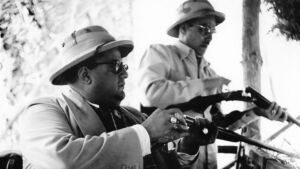Wadiyars (Wodeyars), the rulers of the kingdom of Mysore, started as the Feudatories of the Vijayanagar in 1399. They ruled for more than 500 years ( 1399 to 1947) as vassals and as Independent Kings, till today, the reigns are upheld by the Titular Maharaja of Mysore.
For me, it’s a tribute to be the model of rectitude, to pen down the contributions of ” my” erstwhile Maharaja Shri Jaya Chamaraja Wodeyar, to the upkeep of forests and wildlife in Karnataka, the then Mysore Province. I thank the Family for providing absolute support who buttressed me in piecing together the information and the pictures. I am eternally Grateful indeed!
Happy Reading!
Freeda
The state of Karnataka (earlier Mysore) respects the Wadiyars and their contribution to the Economy, Polity, Society of the people of Karnataka. One of the Dasara Paintings in the Mysore Palace, demonstrates a scene in front of St. Philomena Cathedral, a banner of the times, which postulates, “Long live the King”, clearly indicating the fact that the people were in admiration of their King. There is immense gratitude felt for an act marked in the history and annals, of the Royalty pledging their gold to generate money, to build dams (Vani Vilasa Sagara Dam built by Queen Maharani Kempa Nanjammani Vani Vilasa Sannidhana), which have helped generations and stand a testimony even to this day. Though the twenty-sixth Constitutional Amendment Act of 1971 terminated the Concept of Rulership in India; the Wadiyars still are a cynosure in the eyes of the Kannadigas and others.
My subject here, His Highness Shri Jaya Chamaraja Wadiyar, was especially an ardent lover of nature and wildlife. Considering that the Wadiyar family made genuine efforts to preserve and conserve the wildlife that abounded in the kingdom, the passing of the Mysore Game and Fish Preservation Regulation in 1901 was a date to remember.
There have been times of hunting and capturing animals during their rule. The famous Khedda of the S P Sanderson fame is something History cannot omit. His Highness on ascending the throne ordered extinguishing animals like the Tiger, Panthers and Elephant that had gone rogue. But times did change!
The Central Board of Wildlife was constituted on 4th April 1952, and His Highness was appointed as the Chairman of the Board. The primary objective was Preservation: to prevent the extinction of any species and their protection in balance with the natural and human environment.
Shri Jaya Chamaraja Wodeyar, a people’s person, was crowned the twenty fifth and last ruler of Mysore on 8th September 1940.
HH JCRW’s Contribution To Forests And Wildlife
Prince Jayachamaraja, as he was referred to by his counterparts (Reference made in the book written by Vikram Sampath, Splendours of Mysore), and some even calling him Prince Charming, was different form others. He conducted himself like a commoner and was at ease with himself. Vikram goes on to write that he was modest and shy and a lot studious. He had to his credit, a BA degree with five Gold Medals, from Mysore University.
Some of his remarkable contribution to the laws of the State Forests, which came to be considered as Game Preserves were:
Kakankote, Begur, Berambadi and Chamrajanagara in the then Mysore District.
Herikalgudda in Hassan District.
Lakwalli, Tegurgudda at Muthodi in Kadur District (now part of Chikamagalur District)
Sacrebyle in the district of Shimoga.
His Highness ensured that:
Salt licks were provided at regular intervals for placing salt in the salt licks meant for animals in the forest.
Bird Sanctuary in Srirangapatna (often referred as the Islands on the River Cauvery).
Identifying Tiger Reserves and Blocks which helped preserve the animal across the kingdom.
Earthern Dams for storing water for the preserve, besides having troughs and cisterns that would benefit the wild animals, during summer months.
Driving wild Elephants from Agricultural lands to help farmers with the crops.
Animals, big and small were captured and sent to the Mysore Zoo. The wildlife staff too would hand over any animals caught to the Sri Chamarajendra Zoo, which today is an important center of Wildlife education.
The Staff also ensured that poaching as an activity was managed and controlled.
Some of the forest guest houses built during the times of the Wadiyars, still exist and serve the visitors even to this day, as the best places of accommodation. The world-famous award winning, Kabini River Lodge run by Jungle Lodges and Resorts was erstwhile hunting lodge of the Wadiyars.
My Forest, Journal of the Karnataka Forest Department, was founded in 1964, and His Highness provided for a message for the journal which accomplished 50 years of service to forestry in 2016.
In the first year of the administration of His Highness (1940), there was a proposal to make the Khedda (See Special Feature at the end) a permanent program at Kakankote and three Kheddas were experimented with an intention of:
Putting up a show to the visiting dignitaries
Protecting crops with the capture of elephants who would cause havoc to the crops in the areas of Heggadevankote, Hunsur, Chamrajanagar and Gundlupet
Supply of workers in the forests
And of course, to get elephants for the State Ceremonies, including the Dasara festival.
The creation of reserves and protected areas were something that resonated with the Wodeyars. And of the very famous and most visited today, are no doubt, their note worthy beneficence to the wildlife and forests.
The Ranganathittu Bird Sanctuary, was established in 1940, under the guidance of Ornithologist Salim Ali. The sanctuary attracts nearly more than three lakh visitors every year. The Ranganathittu area was formed when Narasaraja Wadiyar I (1638-1659) constructed an embankment across the Cauvery in 1648.
The Bandipur National Park, was once a private hunting reserve for the Wadiyar family. A Sanctuary with an extant of 90 Kilometers square (35 square miles) was created in 1931 during the tenure of Krishnaraja Wadiyar IV (1894-1940) and was christened as the Venugopla Wildlife Park. Bandipur became a Tiger Reserve under Project Tiger in 1973, with an addition of 800 square kilometers to the Venugopala Wildlife Park.
Talking of their favorite abode, Chamundi hill (earlier known as Marbbala Betta (Thirtha) or Maabala Betta), was popular with the Royalty from as early as the 10th century. It is recorded, that the Hoysala King, Vishnuvardhana had given grants to the temple. It was under the Wadiyars that the Chamundi hill got a status of importance. It was from the time of Chamaraja Wadiyar IV (1572-1576) that Chamundi hill, became famous, in fact, Goddess Chamundi became the family deity. The hill received complete support from the family when Dodda Devaraja Wadiyar (1659-1673) got one thousand steps constructed (1664) for the benefit of pilgrims and these are, to date being used by visitors to trek up. He also got the monolithic statue of the Bull God (Nandi) carved midway. There is wildlife and tree cover around the slopes of the hill, with sighting of predators too. Devikere, a holy pond is close to the temple as well. The temple atop the Chamundi Hill was renovated during the reign of Krishnaraja Wadiyar III (1799-1831) in 1827.
The famous Mysore Zoo (officially the Sri Chamarajendra Zoological Gardens) is a 157-acre (64 ha) zoo located near the palace in Mysore. It is one of the oldest and most popular zoos in India, and is home to a wide range of species. Mysore Zoo was created in 1892 on 10 acres (4.0 ha) of the summer palace of Maharaja Sri Chamaraja Wodeyar, and was originally called the Palace Zoo. The zoo was originally set up by G.H. Krumbiegel, a German landscaper and horticulturist. By 1902 the zoo had expanded to 45 acres (18 ha) with spacious enclosures that are still in use. 1902 was the turning point in the history of the Zoo, when it was thrown open to the public. By then the Zoo had an artificial lake and even a bandstand, a hall mark of the English contribution to open spaces. Post-Independence (1948), the Zoo was handover over to the Department of Parks and Gardens of the Mysore Government. The zoo was expanded first with another 50 acres (20 ha), and then another 150 acres (61 ha) with the acquisition of the Karanji Tank (Karanji reservoir), in which an artificial island has been created as a sanctuary for birds. 1992, was a watershed year in the lifeline of the Zoo, as it celebrated its 100 years of existence. The bust of Sri Chamaraja Wadiyar X (1881-1894), founder of Mysore Zoo was unveiled during the 100 year celebrations.
Special Feature: “Khedda”

It is not known exactly when the actual Khedda was conducted, it probably happened during Hyder Ali’s reign in the 18th century. But the technique of Khedda was propounded by Rao Bahadur M. Muthana, Conservator of Forests in 1910.
Khedda or kheddah, means a “ditch” which was a stockade trap for the capture of elephants by the joint strategic efforts of skilled mahouts and domesticated elephants called, kumkis. This practice brought about the capture of wild elephants to be trained and domesticated for use in the armies and other chores, including capturing wild elephants in the future (as kumkis). This operation was also used to control the population of wild elephants, to have a check on their numbers. It brought in revenue in the form of tourism, as people from far and wide came to witness this glorious act of sheer courage and might. Some very famous personalities who were brough as guests to watch and the Khedda operations were UK King Edward VIII, Prince Albert Victor, the Prince and Princess of Wales, Grand Duke of Russia, Lord Minto, the Viceroy and Governor-general of India, Lord Hardinger, the then President Dr. Rajendra Prasad, K. Kamaraj, Chief Minister of Madras, N. Sanjiva Reddi, Congress President were some of the VIP’s.
From 1799 to 1971, when the last of the Khedda operations were held, the pachyderms were captured by the ecological resources of the river with low water draught, with people participating and invitees and guests watching the grand spectacle. The operation was deftly planned over months, and then executed within the shortest possible time, with the elephants being driven across the River Kabini and from then on into the trenches that would be dug for the purpose. It has been gazetted that, the earliest of Kakanakore river drives (Khedda) of the elephants to bring them into captivity was designed by GP Sanderson in honour of the visit of the Grand Duke (of Russia) way back in 1891. It has been estimated that, a total of 36 Kheddas were conducted in over 190 years. The the moist deciduous forests of Kakanakote were interspersed with bamboo, an ideal location for the operation, as the pachyderms had no shortage of food or the supply of which should be sought from elsewhere.
At first, a herd of elephants would be located and its habits studied. A suitable site many miles away would be located and a large stockade built. Human beaters would then surround the herd from far away and slowly tighten their noose around the herd without alarming them. The herd would be slowly driven unknowingly towards the stockade. And then with a final push would be driven into the stockade. The Kakanakote Khedda had one unique feature – the river drive, where the elephants were driven across the Kabini river into an enclosure.
The area where the Khedda took place is submerged under the tyrants of Dam waters TODAY; but still brings in visuals of the yesteryear’s episodes. Besides the Khedda at Kakanakote, similar operations were attempted in Nanjangud; Chamrajanagar, Chikmagalur and Shimoga. The Khedda at Kakanakote no doubts stands out as an episode of ingenuity in the transportation of the elephants from the wild into the domesticated way of life that helped the humans in all aspects of life.
After unsuccessful attempts by historical figures such as Hyder Ali, Tipu Sultan and Col. Pearson, the first successful Khedda was conducted by GP Sanderson in honour of the visit of the Grand Duke of Russia way back in 1891.
If our Sanskrit texts did make a mention of Elephants and their capture; the foreign visitors to India too have made mentions which will help one assuage the knowledge that the people of the age and time possessed. Megasthenes (350 – 290 BC), the Greek Ambassador to India, does make a mention of Elephants and their capture, which by description was similar to the techniques that were adopted in the 19th and 20th centuries, before the Act of 1972 closed the Khedda operations.
After the failed attempts of Haider and Tipu the other attempts were as follows:
| 1 | Col. Pearson | British Army | 1867 | Failed in the attempt |
| 2 | GP Sanderson | Irrigation Department | 1873 | First Attempt, no capture |
| 3 | GP Sanderson | Irrigation Department | 1874 | Successful (BudipagaHills, Karadihalli) |
| 4 | GP Sanderson | 1875 | Successful |
From 1874 onwards till 1970-71 a total of 36 Khedda Operations were conducted for capturing the wild pachyderms.
| Sl No | Location | Year | Number elephants captured |
1 | Budipaga (Biligirirangana Betta) | 1889 | 51 |
2 | Budipaga (Biligirirangana Betta) | 1890 | 37 |
3 | Kakankote | 1890-91 | 107 |
4 | Kakankote | 1891-92 | 75 |
5 | Kakankote | 1892-93 | 76 |
6 | Chamrajanagar | 1893-94 | 50 |
7 | Kakankote | 1895-96 | 33 |
8 | Kakankote | 1896-97 | 170 |
9 | Gopalswamy Betta | ||
10 | Kakankote | 1897-98 | 27 |
11 | Kakankote | 1898-99 | 17 |
12 | Kakankote | 1905-06 | 78 |
13 | Kakankote | 1909-10 | 91 |
14 | Kakankote | 1913-14 | 109 |
15 | Chamrajanagar | 1917-18 | 33 |
16 | Kakankote | 1919-20 | 50 |
17 | Kakankote | 1922-23 | 22 |
18 | Kakankote | 1923-24 | 51 |
19 | Budipadaga | 1925-26 | 33 |
20 | Kakankote | 1929-30 | 88 |
21 | Kakankote | 1935-36 | 60 |
22 | Kakankote | 1938-39 | 50 |
23 | Kakankote | 1939-40 | 80 |
24 | Kakankote | 1940-41 | 7 |
25 | Budipaga | 1945-46 | 44 |
26 | Budipaga | 1946-47 | 156 |
27 | Kakankote | 1948-49 | 35 |
28 | Kakankote | 1949-50 | 38 |
29 | Kakankote | 1953-54 | 71 |
30 | Kakankote | 1960-61 | 66 |
31 | Kakankote | 1967-68 | 88 |
32 | Kakankote | 1970-71 | 47 |
























Kakanakote no doubt was the epicentre of the Khedda operations in Mysore/Karnataka; but after the construction of the Kabini Dam, which was built in 1974 on the River Kapila and had a length of 696 meters in length, height of 166 feet and a storage capacity of 19.52 TMC feet; the entire area under the Khedda operation lay submerged because of the catchment area (2,141.90 km2) that the Dam had created.
One needs to note that, the Khedda operations brought in lot of elephants to the British Administrators and the to the Wadiyar Dynasty. The best of the Elephants were used by the Palace Gajashala Department for display during the Dasara Celebrations in the city of Mysore. The noting of the Durbar Bakshi of the Palace clearly indicates the same. Some of the well-built elephants were even categorically designated to as the Ambari Elephant, Howda Elephants; which meant that care was taken to identify the right fit. At times, if there was a shortage of elephants for the Khedda, the tamed elephants were even hired from the Madras Forest Department as per the records of the Durbar Bakshi.
The Enactment of The Wild Life (Protection) Act of 1972; which was an Act to provide for the protection of wild animals, birds and plants and for matters connected therewith or ancillary or incidental thereto with a view to ensuring the ecological and environmental security of the country; became a milestone in Forest, Wildlife, Flora and Fauna; preservation and conservation. True the Khedda, which we had heard as kids in our Geography classes on the environment; too came to end, yes, for protecting the elephant; which was considered to be an endangered species.














